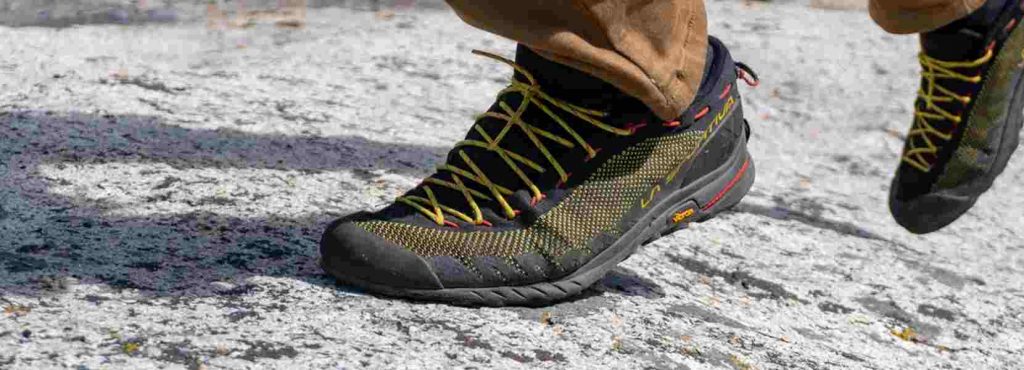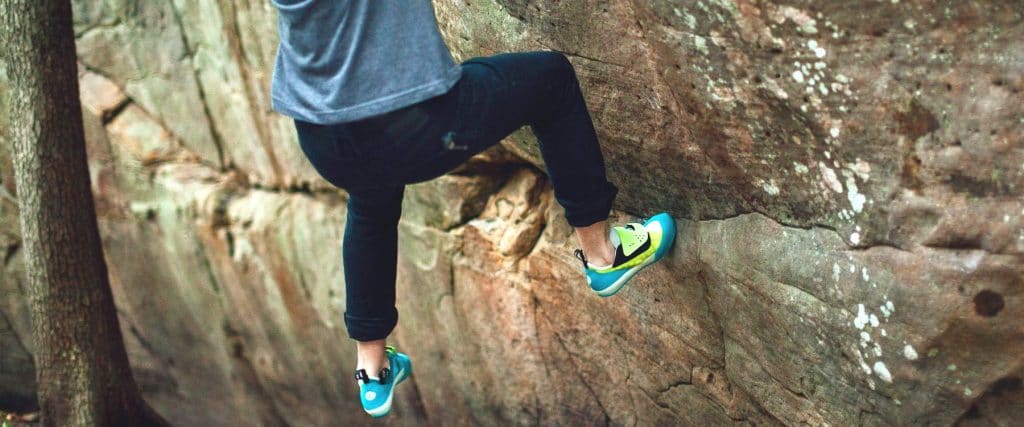

Rock climbing is an exhilarating sport that tests your endurance and skills. Of course, like with any sport, you need the proper equipment. One of the most important parts of your gear is the shoes, which are thin pieces that lack padding but include sticky rubber soles to give you some grip when scaling those rock walls. Unfortunately, despite how little there is to this type of footwear, they still require some time to conform to your feet for the perfect fit.
That’s why it is important to learn how to break in climbing shoes before you put them to use. There are a few ways to accomplish this task, depending on how much time you have to break them in and which method you prefer to get this job done. If you’ve never had to break in a pair of climbing shoes before, the following methods can get you started.
Before you can even begin to break in your new climbing shoes, you first need to choose the right pair. The best climbing shoes for one person won’t necessarily be a favorite of someone else, especially with so many sizes and types to choose from, so consider the shoes carefully before making your purchase.
The most important factor when buying any pair of shoes is getting the right size to ensure the shoes fit well without being too loose and causing blisters or tight enough to hurt your feet. Climbing shoes are no different, though they aren’t quite the same as a regular pair of sneakers. These shoes are meant to be somewhat snug, though not uncomfortably so.
Whether you’re choosing the best beginner climbing shoes or a more advanced pair, they should have the right fit to enhance your climbing skills rather than interfering with them. To be sure you have the right size, push your forefoot into the shoe all the way to the end. There should be no space between your toes and the ends of the shoes. In fact, your toes should be slightly curled. Then slip the back of the shoe over your heel. The shoe should be snug, with no loose or bunched areas.
You should also keep in mind that the best women’s climbing shoes are somewhat narrower in the heel cup, lower around the ankles, and have a lower volume around the forefoot to accommodate a woman’s narrower foot. They should have the same snug fit that we described above but if you’re trying a unisex or men’s climbing shoe, you’ll likely need to go down a size or two to fit the shoe properly.
There are 4 types of climbing shoes Trusted Source 4 Types of Climbing Shoes: How to Choose Climbing Shoes - 2022 - MasterClass Climbing shoes are specially crafted performance shoes used in rock climbing. They are typically made of both leather and synthetic materials and secured with velcro, although lace-up shoes also work for certain purposes. The market is filled with climbing shoe options from established brands as well as newer brands with their own dedicated users. Some are specialized for specific types of climbing. www.masterclass.com to pick from, depending on the type of climbing you plan to do. These include Trad, Sport, Gym, and Bouldering. These shoes vary in the downturn and stiffness and work well for different types of climbing. For instance, the Gym climbing shoes are great for beginners or gym-goers, while the Bouldering climbing shoes are high-performance footwear for rapid ascents up rugged terrain.
There are also two main materials used to make climbing shoes. These are leather or synthetic materials, though some shoes use a combination of the two. Leather is the more durable option, plus it tends to expand more, forming to the shape of your foot. Synthetic material is stiffer and helps with moisture regulation, though it likely won’t stretch more than half a size, so you need to be extra careful when sizing these shoes.
If you are interested in learning how to stretch out climbing shoes, you’re in luck. There are a few different methods to choose from, depending on the type of shoe and how much time you have available to put into this task.
One easy method of breaking in climbing shoes involves the use of hot water. This method is best for leather shoes with more give but can also work on synthetic climbing shoes. Start by removing any packaging and stickers from the shoes. Then put them on and secure them snuggly.
Turn on the water in your bathtub or shower, adjusting the temperature until it is hot but won’t burn you. Get into the tub or shower and let the water flow over your shoes, soaking them through. Wiggle your toes a bit to begin the stretching process. Keep the shoes in the water for a few minutes, then leave the shower and find somewhere that you can sit and relax while the shoes begin to dry.
Once they are about halfway dry, remove the climbing shoes. Stuff them with newspaper or socks and let them dry some more. Before they are completely dry, remove the paper or socks, put them on again, and do some climbing on your home rock wall or at a gym that allows damp shoes on their equipment. This will help the shoes stretch a bit more to fully mold to your feet.
When you’re done climbing, replace the paper or socks in the shoes. Let them dry completely and then try them on again. If they aren’t comfortable yet, repeat this process until they have fully molded to your feet.
Plastic bags can be used to stretch out any type of climbing shoes, whether you’re using leather models or synthetic ones like the Tenaya Oasi Climbing Shoes, with their speed lace Velcro system and cotton lining. For this method, cut a plastic bag to just cover your foot or even just your heel. Then slip it on over your foot. When you put your shoe on over it, the plastic will help the shoe slide on more easily. Then wear your shoes around the house and even do some climbing in them. It may take a while for the shoes to fully form to the shape of your foot, though, so don’t expect quick results with this method.
Another way to stretch climbing shoes is to just wear them. Simply put them on and wear them while you’re watching television, listening to music, or reading. Try not to walk around in them too much, though, since this can alter the structure of the shoe, making them less useful for climbing. Climbing in your shoes can speed up the process of breaking them in.
It can be somewhat painful at first, as with any type of new shoe, but the more often you climb in them, the more comfortable they’ll feel.
Bags of ice are another easy way to break in your climbing shoes, plus it is the least painful method since you don’t actually have to wear them during this process. Be sure to use freezer bags Trusted Source Difference Between Freezer Bags & Regular Zip-Top Bags | Kitchn Freezer bags and regular zip-top bags are both made from durable plastic, typically have a similar type of seal, and are available in the same sizes. There is one important difference that sets them apart: thickness. www.thekitchn.com rather than regular zipper bags since the former are much thicker and stronger, so they won’t tear easily.
Take two freezer bags and fill them with water until each one is about the same size as one of your feet. Seal them and then place a bag of water into each of the climbing shoes. Lace the shoes loosely over the bags and put them in the freezer overnight. As the water freezes, it will expand inside the shoes, stretching them out.
In the morning, remove the shoes from the freezer and let the ice thaw. Remove the bags of water from the shoes and try the climbing shoes on. If the shoes are comfortable, you’re ready to start climbing. If they are still too tight, repeat this method as many times as needed until they are the perfect size.
Though we’ve discussed various methods for breaking in your climbing shoes, you may still have a few concerns about your new shoes. The following are most commonly asked.
It usually takes about 3 to 5 climbs to fully break in your climbing shoes, though this depends on the materials used to make the shoes. Leather is a bit more compromising, so they tend to loosen up quicker than synthetic shoes. If you try the above methods to break in your shoes, you may be able to speed up this process. You may not experience as much pain either since the hot water method loosens up the shoes quicker while the ice bags stretch them out for you, so you don’t even need to have them on your feet while they are broken in.
Most climbing shoes do stretch a bit over time, though how much they stretch depends on the material used to make the shoes. The natural fibers of leather have a bit more give to them, so they can stretch up to 2 full sizes as long as there is no synthetic lining holding the in place. Synthetic material doesn’t stretch as well, so you won’t be able to stretch them more than half a size, even with the methods that we described above.
No, kids’ climbing shoes don’t stretch quicker than adult shoes. They are made of the same materials and have the same type of stiffness as adult shoes to give them the grip needed when climbing. The issue is that kids are more likely to quit climbing if their shoes aren’t comfortable. Kids’ feet also grow constantly until they are teenagers, so you can even go up a size if needed to ensure the shoes can be used for longer while still keeping their feet comfortable. You may also want to get a pair with Velcro closures, like the Butora Youth Brava Climbing Shoe, since this allows them to tighten them as much as they need to on their own and gives them some room to grow.
Climbing shoes are an essential part of your gear since they give you the grip you need to scale those rock walls while maintaining your foot comfort at the same time. Though these shoes can be stiff and uncomfortable when you first purchase them, learning how to break in climbing shoes can help you speed up this process.
As we’ve discussed above, there are several methods that you can try. Wearing the shoes, with or without a plastic bag, is the best method for the perfect form-fitting shoes. If they only need a bit of stretching, the hot water method is also a good option, while the ice bags work well for shoes that need a larger stretch. Once the shoes are ready to go, you can get back to your favorite pastime.





